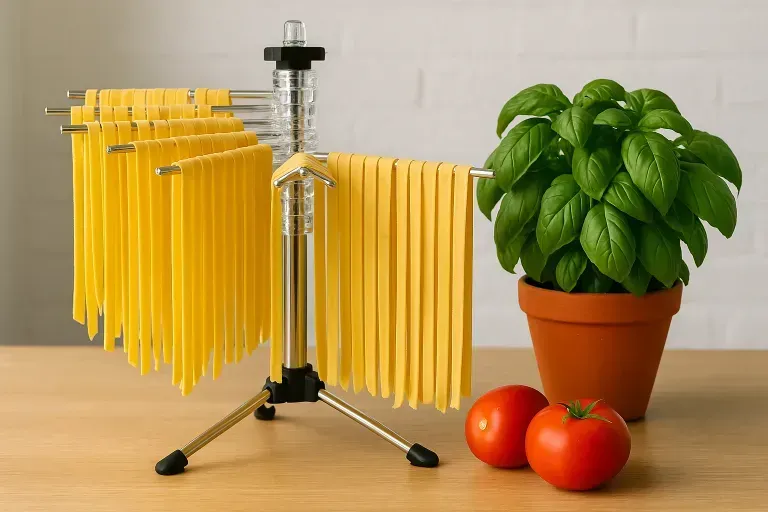Homemade pasta – The perfect recipe for fresh spaghetti, fettuccine and lasagna sheets
- 1 hour
- Medium
- 4 servings

Fresh homemade pasta is a true Italian classic that tastes far better than store-bought. With this recipe, you can easily make pasta from scratch using tipo 00 flour – perfect for classic spaghetti, fettuccine, or lasagna sheets.
Fresh pasta has a soft and elastic texture that absorbs sauces better and delivers an authentic Italian dining experience.
By kneading the dough thoroughly and using a pasta machine, you ensure a smooth and even texture. Alternatively, you can roll it by hand for a more rustic finish.
Once the pasta is ready, you can either cook it immediately or let it dry slightly if you want to save it for later. Serve with your favorite sauce and enjoy the full flavor of fresh homemade pasta!
Ingredients
Pasta
- 10.6oztipo 00 flour
- 5.3ozeggs
- 0.5tsp.salt
Cooking
- 2.6quartswater
- 2tsp.salt
Tools
- Knife
- Plate
- Plastic wrap
- Pasta roller
- Pasta cutter
- Stand mixer
- Pot
Tips
- A medium egg weighs about 1.76 oz without the shell. That means this recipe uses roughly 6 eggs.
- Make the well for the eggs larger than you think – about 3.9 inches diameter for a standard batch.
- It can be physically demanding to knead the dough by hand.
- If the dough looks frayed at the edges or seems crumbly, fold it one third in from each side and run it through the pasta roller on a wide setting.
- You can use the pasta sheets from step 10 directly for lasagna. Trim the edges for even rectangles.
- Use one hand to support and guide the pasta while flattening and cutting.
- If you’re making spaghetti carbonara, reduce boiling time by 1–2 minutes since it cooks further in the sauce.
- Fresh pasta can stay warm for 30–60 minutes in the pot with the lid on, but it’s best served right away. Add a bit of butter or oil to prevent sticking.
- Never wash pasta rollers or cutters with water as it will ruin them. Always clean with a dry brush.
Goes well with
- Italian dishes
- Tomato sauce
- Pesto
- Cream sauce
- Meat dishes
- Vegetarian dishes
Instructions
1
Place a bowl on a digital scale and reset it. Crack in the eggs until you reach the desired weight. Save any leftover egg white in a separate bowl—it may come in handy if the dough feels too dry later.
2
If using a stand mixer, add the flour to the bowl and make a well in the center. If making the dough by hand, do the same directly on the table.
3
Add eggs and salt to the well and mix with the flat beater (K-paddle) or a fork until the dough starts to come together. If it feels too dry, gradually add some of the reserved egg white.
4
Replace the K-paddle with the dough hook and knead for 2–3 minutes in the machine, or knead by hand for 8–10 minutes until smooth and elastic. Be sure to stretch the dough well during kneading to develop the gluten.
5
Shape the dough into a large ball, cover it with plastic wrap or place it in a plastic bag, and let it rest at room temperature for at least 30 minutes to relax the gluten.
6
After resting, cut the dough into 2–4 equal parts with a knife to make it easier to roll out.
7
Use a rolling pin to flatten one piece slightly, or press it down with your hand, so it can fit into the pasta roller.
8
Run the dough through the widest setting of the pasta roller to create a flat, even sheet.
9
If the dough is uneven, fold one third in toward the center, then the other third over it, and pass it through the roller again at the same setting.
10
Continue rolling through progressively thinner settings until you reach the desired thickness.
11
Use the pasta cutter to slice the sheets into long strands like fettuccine or spaghetti. For lasagna, leave the sheets whole without cutting.
12
Hang the cut pasta on a drying rack and let it dry slightly while you prepare the cooking water.
13
Boil fresh pasta in a large pot of generously salted water for 4–5 minutes until al dente. Stir during cooking to prevent sticking.
14
Taste the pasta to check for doneness. When it has a slight bite, drain it and optionally stir in a bit of butter to prevent sticking. Enjoy!
Homemade pasta: Frequently Asked Questions & Answers
What is the best flour for homemade pasta?
Tipo 00 flour gives a silky smooth pasta. Semolina is good for thicker shapes, and all-purpose flour works too, but may need more kneading to activate the gluten.
Can I make gluten-free pasta?
Yes, use gluten-free flour, eggs, and xanthan gum to make flexible dough without gluten.
How do I stop fresh pasta from sticking together when cooking?
Dust the pasta with flour or semolina before cooking and stir it during boiling. Use plenty of salted water.
How should I store homemade pasta?
Store fresh pasta in an airtight container in the fridge for up to 2 days, or freeze it for up to 2 months. Dust with flour to prevent sticking.
Can homemade pasta be frozen?
Yes. Freeze the dough as shaped balls or freeze cut pasta on a tray. Let it thaw slowly before rolling or cooking.
Nutritional Information
Calories
Carbohydrates
Fat
Protein
Thank you for visiting Food Recipe app! We hope you enjoyed this recipe for Homemade pasta. We greatly appreciate your interest and hope you found inspiration for your meals. Here are some other recipes from our site that we believe you will love:
